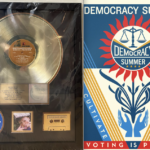[oldembed src="https://www.youtube.com/embed/JuEjXDsXwIg" width="425" height="300" resize="1" fid="21"]
I live in an area that's been solidly working class for decades. Now I see grown men and women standing at intersections, begging for change from passing cars. What is left in the system for people who have run out of options? Not much. When Bill Clinton changed "welfare as we know it," it left an awful lot of people out in the cold.
The wingnuts don't see it that way, of course. (See the Heritage Foundation video above.) Oh no, they want to cut even more — to give poor people "hope."*
The people who've lost their jobs and tapped out unemployment benefits aren't eligible for help. That's because the bare-bones system only gives benefits to the hardcore, chronically poor without assets.
And for those people who are eligible, times are so hard, they're selling off their food stamp cards for cash.
Conclusion: If a rising tide lifts all boats, an ebbing tide leaves them stranded without food, medical care or housing. Progress!
To keep her lights on, Rosa Pena, 24, sold the groceries she bought with food stamps and then kept her children fed with school lunches and help from neighbors. Her post-welfare credo is widely shared: “I’ll do what I have to do.”
Critics of the stringent system say stories like these vindicate warnings they made in 1996 when President Bill Clinton fulfilled his pledge to “end welfare as we know it”: the revamped law encourages states to withhold aid, especially when the economy turns bad.
The old program, Aid to Families with Dependent Children, dates from the New Deal; it gave states unlimited matching funds and offered poor families extensive rights, with few requirements and no time limits. The new program, Temporary Assistance for Needy Families, created time limits and work rules, capped federal spending and allowed states to turn poor families away.
“My take on it was the states would push people off and not let them back on, and that’s just what they did,” said Peter B. Edelman, a law professor at Georgetown University who resigned from the Clinton administration to protest the law. “It’s been even worse than I thought it would be.”
But supporters of the current system often say lower caseloads are evidence of decreased dependency. Many leading Republicans are pushing for similar changes to much larger programs, like Medicaid and food stamps.
Representative Paul D. Ryan of Wisconsin, the top House Republican on budget issues, calls the current welfare program “an unprecedented success.” Mitt Romney, who leads the race for the Republican presidential nomination, has said he would place similar restrictions on “all these federal programs.” One of his rivals, Rick Santorum, calls the welfare law a source of spiritual rejuvenation.
“It didn’t just cut the rolls, but it saved lives,” Mr. Santorum said, giving the poor “something dependency doesn’t give: hope.”*
President Obama spoke favorably of the program in his 2008 campaign — promoting his role as a state legislator in cutting the Illinois welfare rolls. But he has said little about it as president.
Even in the 1996 program’s early days, when jobs were plentiful, a subset of families appeared disconnected — left with neither welfare nor work. Their numbers were growing before the recession and seem to have surged since then.
It's long past time before we had the public discussion about what we want as a nation. Do we want wars — or jobs? Do we want tax cuts — or decent housing, education and infrastructure? Do we want to give multinational corporations more tax loopholes — or do we want to give senior citizens the health care they need?
We need to stop letting the media discussion follow the latest shiny object and decide what we really, truly want America to be.



















